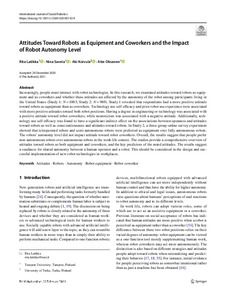Attitudes Toward Robots as Equipment and Coworkers and the Impact of Robot Autonomy Level
Latikka Rita; Savela Nina; Koivula Aki; Oksanen Atte
https://urn.fi/URN:NBN:fi-fe2021042827563
Tiivistelmä
Increasingly, people must interact with robot technologies. In this research, we examined attitudes toward robots as equipment and as coworkers and whether these attitudes are affected by the autonomy of the robot among participants living in the United States (Study 1: N = 1003; Study 2: N = 969). Study 1 revealed that respondents had a more positive attitude toward robots as equipment than as coworkers. Technology use self-efficacy and prior robot use experience were associated with more positive attitudes toward both robot positions. Having a degree in engineering or technology was associated with a positive attitude toward robot coworkers, while neuroticism was associated with a negative attitude. Additionally, technology use self-efficacy was found to have a significant indirect effect on the associations between openness and attitudes toward robots as well as conscientiousness and attitudes toward robots. In Study 2, a three-group online survey experiment showed that teleoperated robots and semi-autonomous robots were preferred as equipment over fully autonomous robots. The robots’ autonomy level did not impact attitude toward robot coworkers. Overall, the results suggest that people prefer non-autonomous robots over autonomous robots in the work-life context. The studies provide a comprehensive overview of attitudes toward robots as both equipment and coworkers, and the key predictors of the noted attitudes. The results suggest a readiness for shared autonomy between a human operator and a robot. This should be considered in the design and successful implementation of new robot technologies in workplaces.
Kokoelmat
- Rinnakkaistallenteet [27094]
